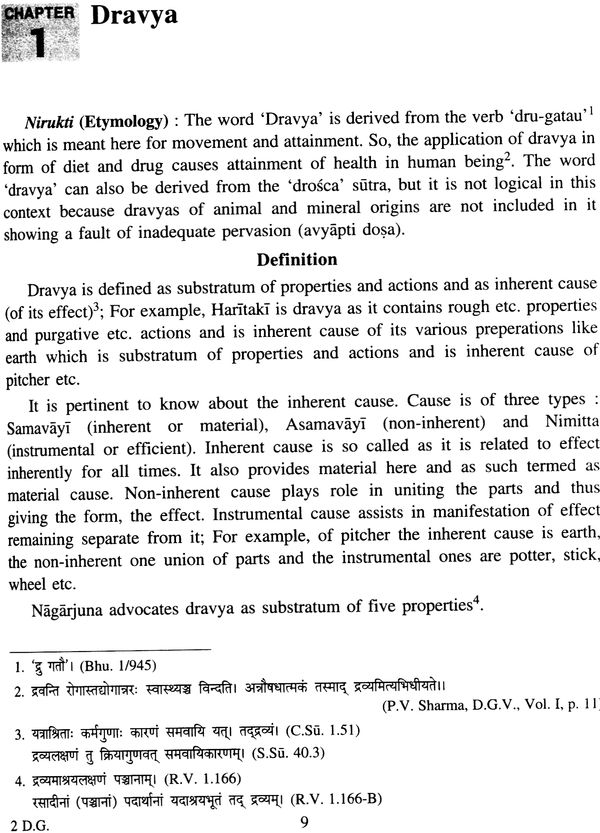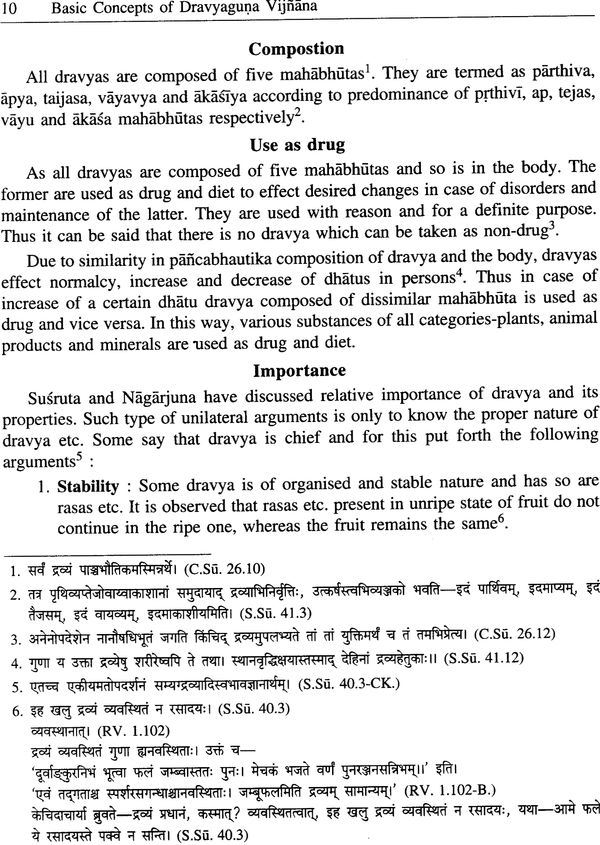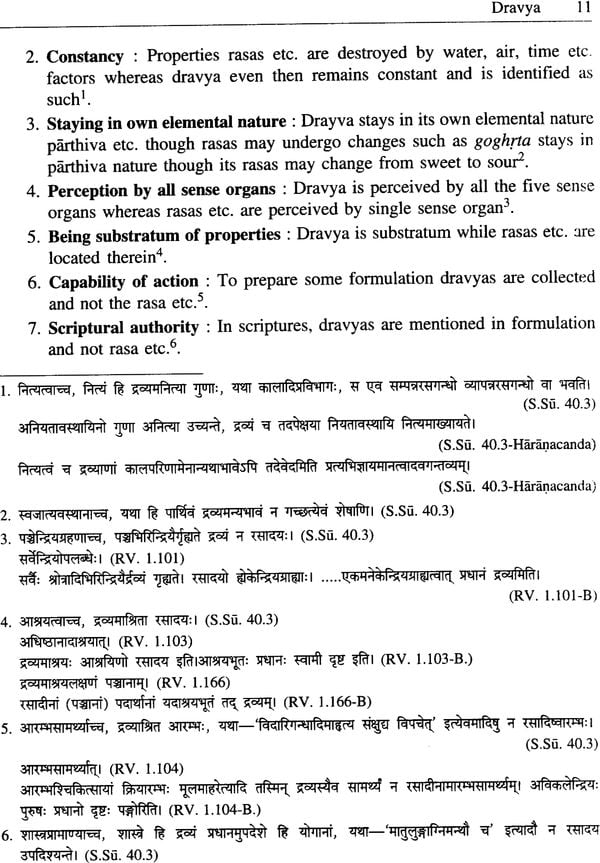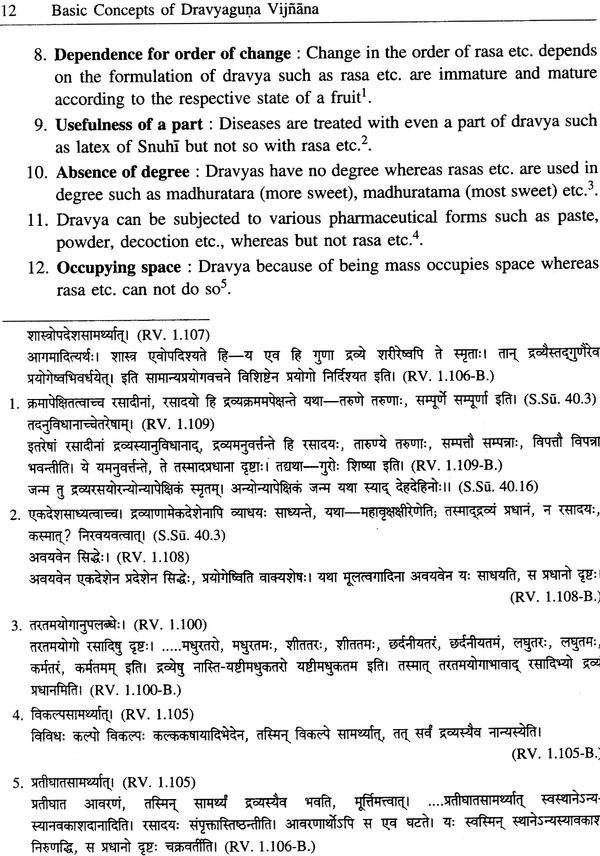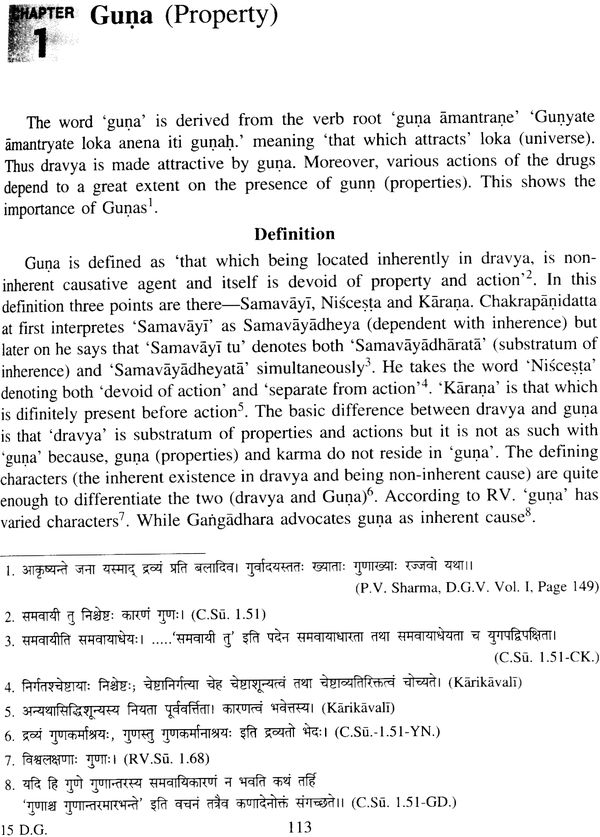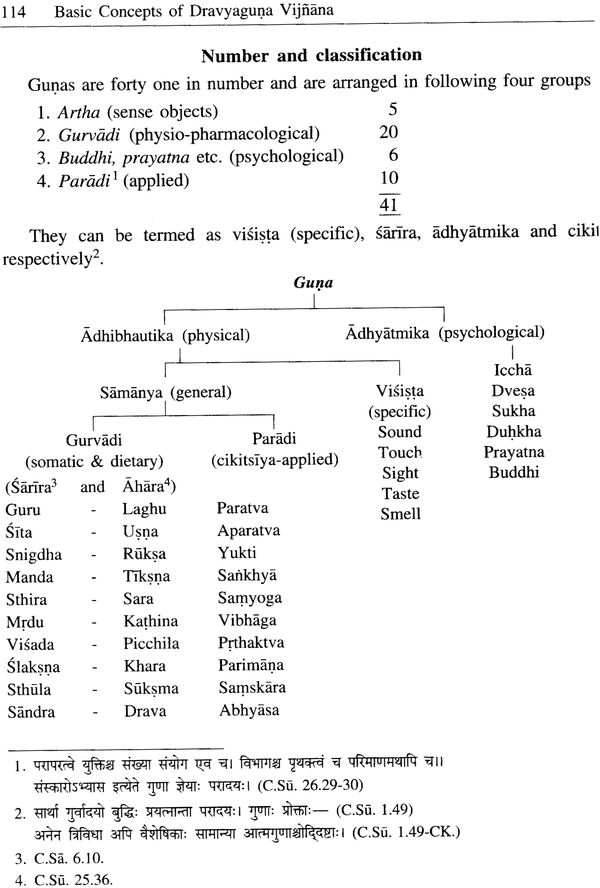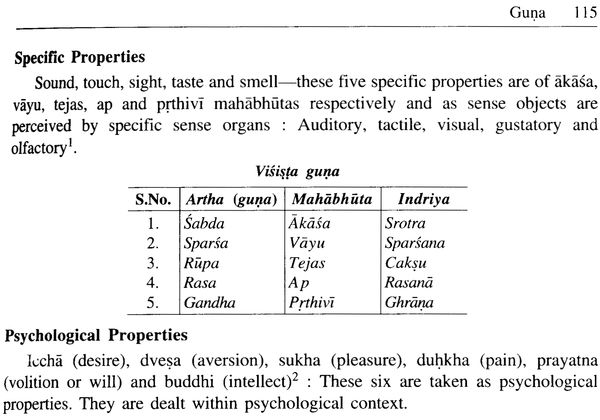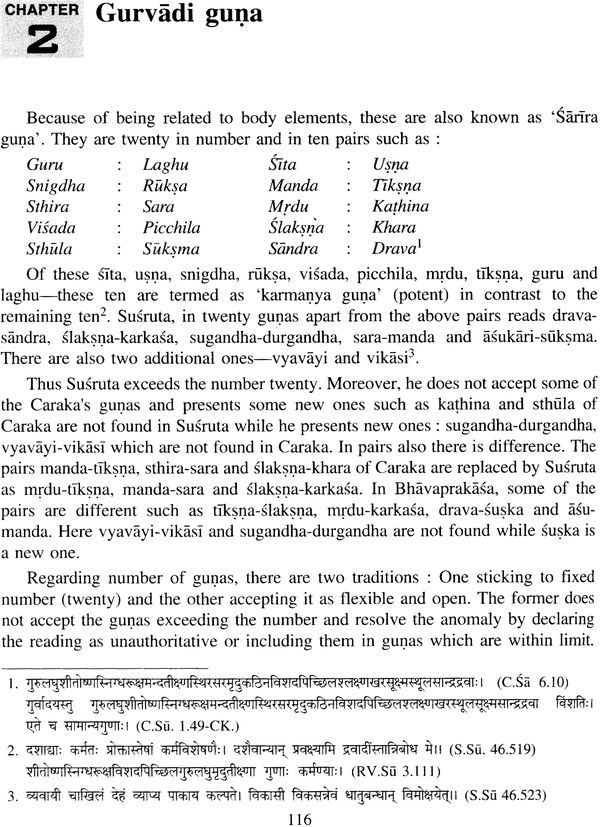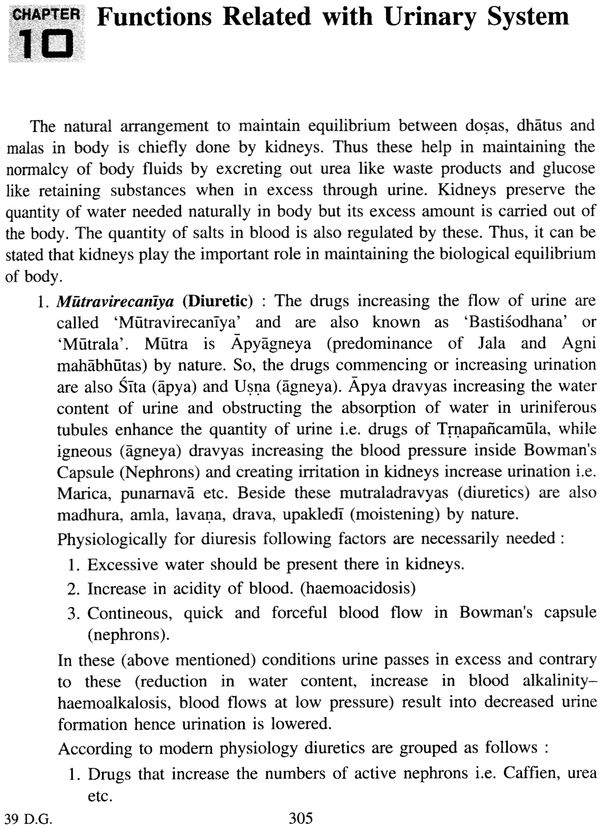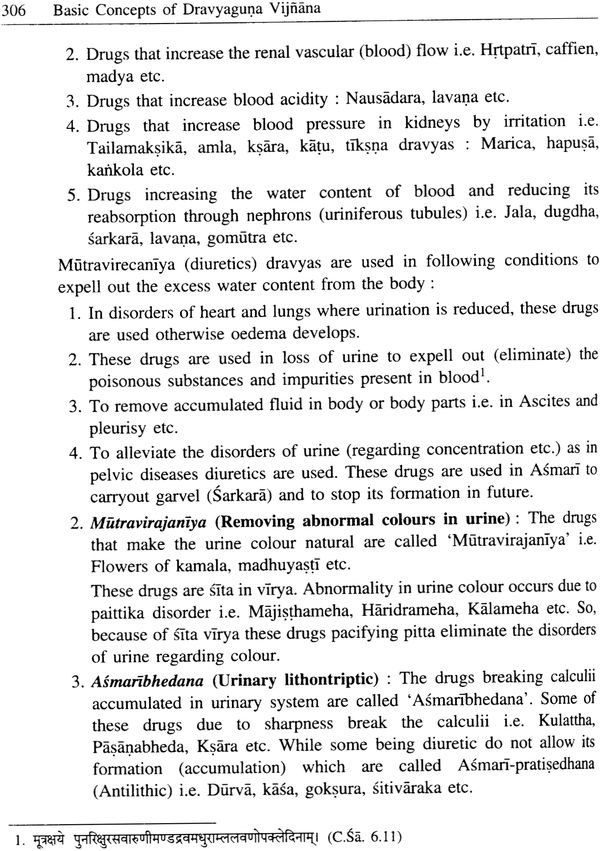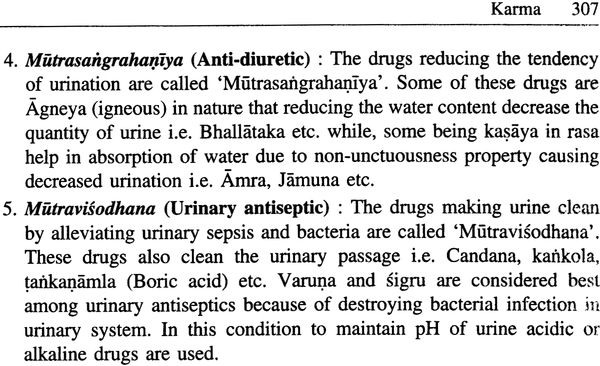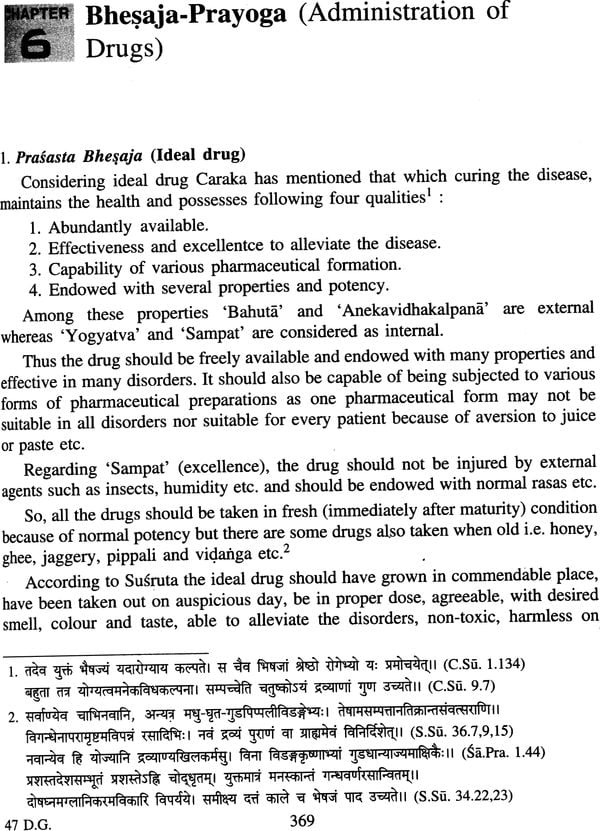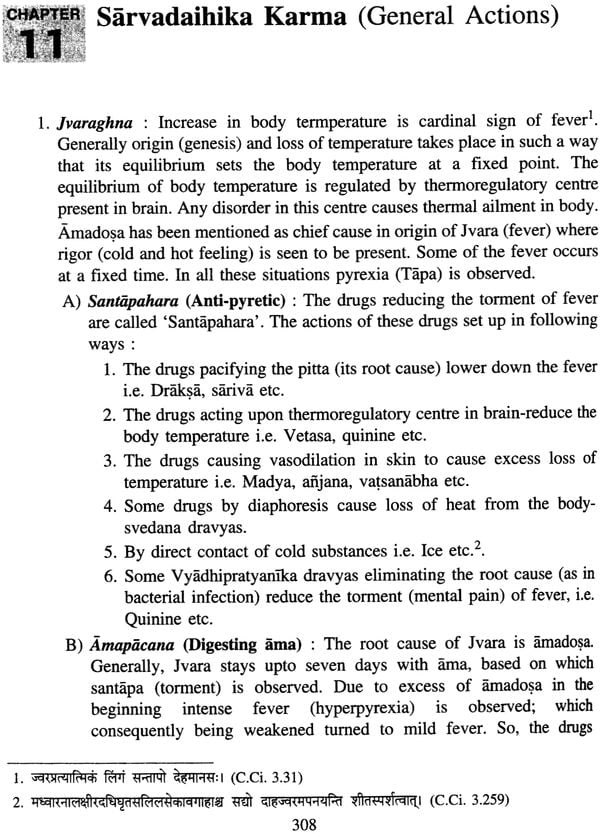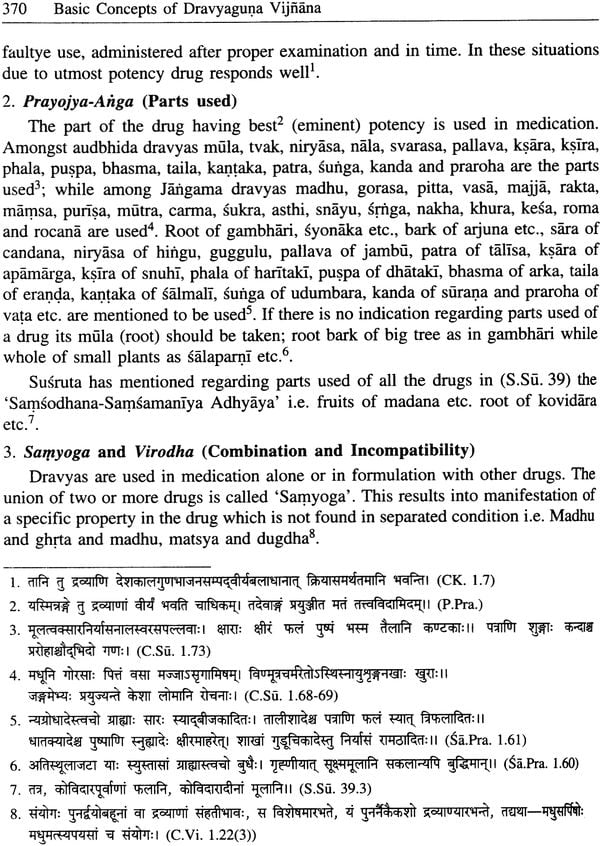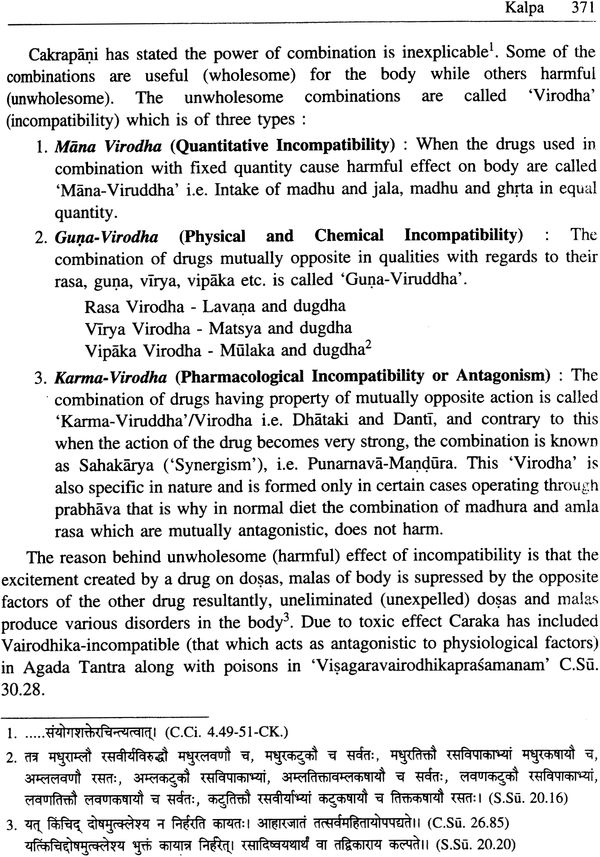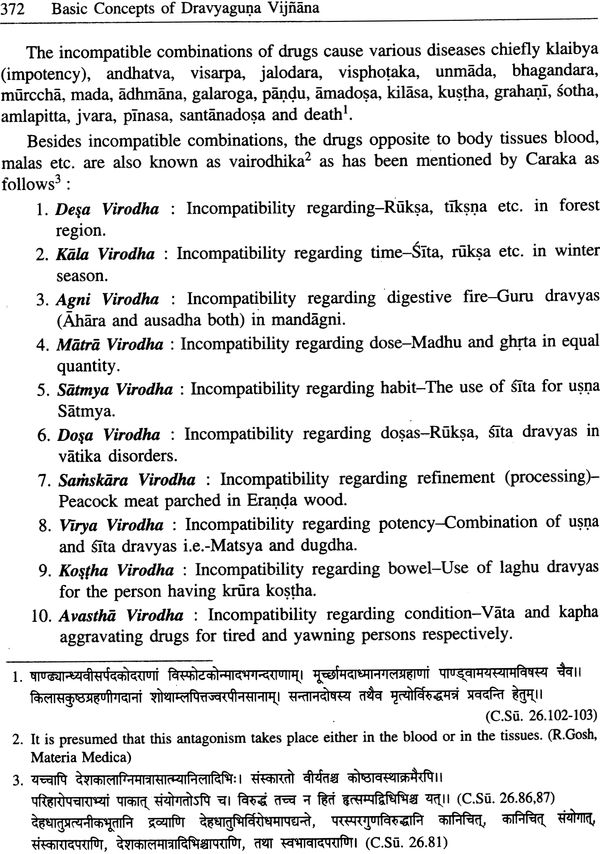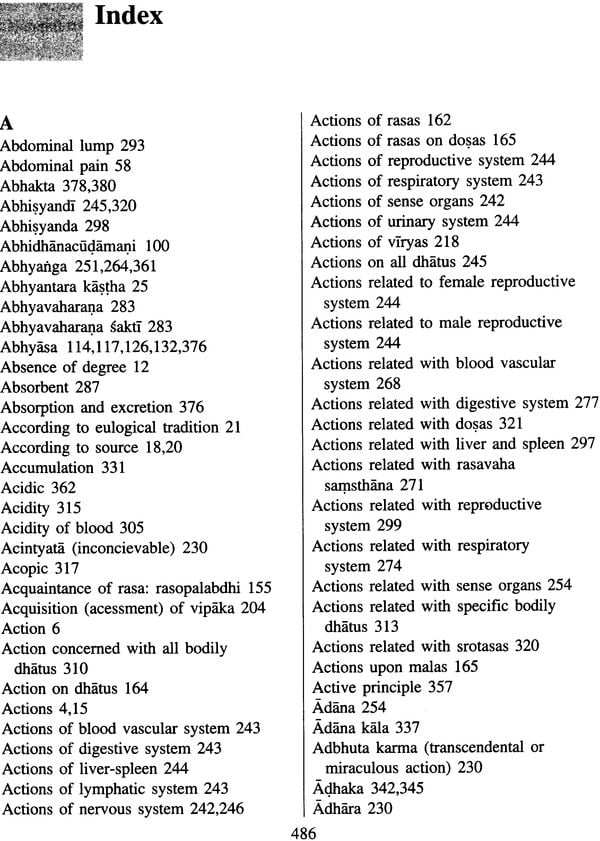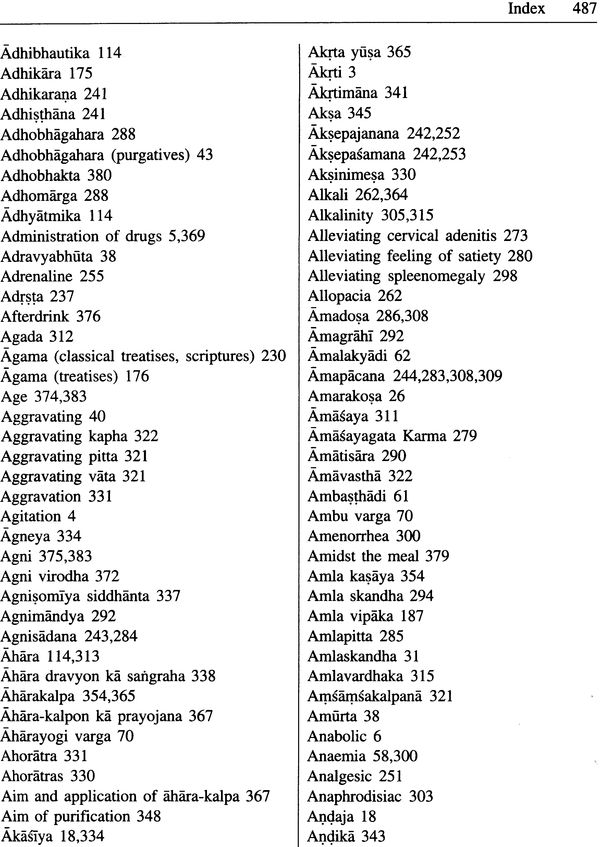
Basic Concepts of Dravyaguna Vijnana
Book Specification
| Item Code: | NAF779 |
| Author: | Dr. Anugrah Narain Singh and Prof. Satya Deo Dubey |
| Publisher: | Chaukhambha Visvabharati , Varanasi |
| Language: | English |
| Edition: | 2014 |
| ISBN: | 9789381301340 |
| Pages: | 542 |
| Cover: | Paperback |
| Other Details | 10.0 inch x 7.5 inch |
| Weight | 860 gm |
Book Description
The oldest system of medicine Ayurveda, is a combination of science and philosophy that aspires for the perfect health and development (physical, mental, social and spiritual ) of the individual and the society. The utility of this science consists in the maintenance of health in the healthy and quieting of diseases in the ailings. It is a science of longevity and perfect health which is based on sound fundamental principles which are the highest generalization and have been formulated by various inductive methods and proved by deductive applications.
In the present book Authors have tried their best to present the basics for Dravyaguna in very elaborative and simple way so that all the parameters of dravya (related to drug actions) namely Guna, Rasa, Vipaka, Virya, Karm and Prabhava etc. be easily understood along with brief description of pharmacy (Kalpakhanda) as it is believed to be a part of Dravyaguna. During description special attention has been given regarding references taken from the original texts in form of footnotes wherever necessary which will be very much beneficial in understanding the facts.
Further more, regarding identification of plants through their taxonomic approach an effort has been made to as certain their identity (family wise). In addition to these a glossary related with specific identifying characteristics with topographic representation in separate section will be proved helpful.
In view of above efforts this book will give a new guideline in understanding the basics of Dravyaguna and so Ayurveda as a whole to the students to serve the sufferings Via Ayurveda, the science of life and certainly the oldest system of medicine.
Prof. Satya Deo Dubey born on 10th July, 1945 at village-kuchaura, post-Sikandarpur,Ghazipur (U.P.). He received his Bachelor’s degree in Ayurvedic Medicine and Surgery from Sampurnanad Sanskrit University in 1973. He was awarded D. Ay.M. degree in 1977 and Ph. D. degree in 1985 by Banaras Hindu University. Prof. Dubey put 32 years of service since 1981 at the Banaras Hindu University as Lecturer, Reader, professor and hen Head of the Department of Dravyaguna.
He is a distinguished scholar in the field of Dravyaguna.h e has guided 20 MD (Ay.) and 15 Ph. D. scholars in DRavyaguna and allied subjects also. He has an intense love for teaching in Ayurveda. He has credit to publish 4 books.
Dr. Anugrah Narain Singh being born on 13the January, 1956 in a well educated family at BAheri, Kamlapur, Chandaui, U. P.; started his school carrier in the home village. Graduated in science from Banaras Hindu University (1975), Post graduate in Agriculture from Gorakhapur University, Kanpur University, Kanpur (1982), Post graduate in DRavyaguna from I.M.S., B.H.U., Varansi (1987). Also did Shastri in Sanskrit Sahitya (1999) and Ph.D. in Dravyaguna (2000) from Sampurnanada Sanskrit University, Varansi.
The teaching carrier of the author started as Lecturer in 1996 at Govt. Ayurveda. College, Varansi after approx. 10 years of service e as Medical Officer in U.P. Govt. Health services and presently working as Reader there since 2009. During this period author has participated in various seminars and symposia at national level and has credit to publish 4 books and approx. 20 papers and has guided 6 Ph. D. scholars in Dravyaguna; while 1 book in under press to be published soon which are the little but valuable contribution in the field of Ayurveda specially Dravyaguna.
Bowing in the feet of Pujya Guruji (Acarya Priya Vrat Sharma) we started this work. He always inspired us to do work in the field of Dravyaguna. During conversations he was desirous of further editing and english translation of Dravyaguna Vijfiana authered by Him. His blessing initiated us for this work which was beyond our capacity but we follow his blessings in form of guide lines to move forward.
Dawn of dravyas starts from the Osadhi Siikta of Rgveda : Ayurveda is intimately related with the Vedas which is evident from the fact that the former is regarded as upaveda of Rgveda (because of antiquity) or upaveda of Atharvaveda (because of similarity in approach and the subject matter). However Kasyapa accepts it as fifth veda (Ka.S. Vi-2.10). At a time when vedas became the target of attacks from many comers, Ayurveda was utilised as an powerful instrument for supporting the authoritativeness of the Veda (,-Nyaya Su, 2.1.12. At that time the number of dravyas were very few and the concepts were found in primitive stage. The number of dravyas and conceptual position are found more developed in Atharvaveda. Due to close relation with Vedas Ayurveda follows their ideas along with number of dravyas and different types of new concepts according to need of time and humanity. New concepts like Triodsavada, ojas, detailed description about the drug actions such as concept of rasa, guna, virya, vipaka, prabhava etc. are contributed in Ayurveda. Amongst concepts of Ayurveda Caraka has given the due importance to Dravyaguna that is why he describes first four chapters of Siitra-sthana as Bhesaja Catuska and in the chapter 30th of Sutra-sthana he says that it is so called Ayurveda because it deals with wholesome and unwholesome dravya, guna, karma and which is described all over the treatise.
For the betterment of study of Dravyaguna its subject matter is divided broadly into two parts :
1. Padartha Vijfiana
2. Dravya Vijfiana
In this book, Padartha Vijfiana has been taken into consideration where conceptual study of Dravya, Guna, Rasa, Vipaka, Virya, Prabhava, Karma and Formulations etc. are included. An attempt has been made to make the study matter easy and acceptable. It is high time to discuss the concepts in the rational way on the scientific background. The world is looking towards Ayurveda specially Dravyaguna for providing a healthy life, to maintain health and disease free life. In this condition the duty of Ayurveda scholars is to go for deep study of treatises and draw the gems to fulfill the need of the society as Ayurveda is applied science. The inclusion materials of this book are arranged in four sections where Dravya, its inherently situated properties, actions are elaborately discussed along with various kalpas (formulations and preparations) mentioned namely as : Dravyakhanda, Gunakhanda, Karmakhanda and Kalpakhanda.
In Dravyakhanda dravya and its classification have been exclusively elaborated according to their Morphological, Geneological, Pharmacological and mixed aspects in light of both ancient and modem approaches. Ayurvedic ausadha dravyas are mentioned according to systemwise actions in modem perspective along with a new approach in form of mixed groups resulting into a historically and comparatively thorough discussed form. In the end of this section the history regarding dravya's origin and its chronological development have been included. In Gunakhanda classification of Guna and their effects on bodily Dosas, Dhatus and Malas are excessively explained with examples. Rasa and their actions are also well discussed system wise. A thorough discussion has been put forth regarding various opinions on Vipaka. A radical approach has been subjected regarding nature and classification of Virya and Prabhava. In Karmakhanda the actions of dravyas have. been explained in both modem and ancient perspectives. An effort has been made to explain some of the actions mentioned in modem science on the basics of Ayurvedic concepts. The actions related with Prabhava has been exclusively elaborated in very simple and agreeable manner. The subject matter of Kalpakhanda has been shortened because Bhaisajya Kalpana (Pharmacy) though being a part of Dravyaguna is neither justifiable nor possible to cover within a limited boundry because of its vast literature and utility. So, in this chapter only important and noticiable aspects have been discussed in brief to draw attentions and interests of the scholars. For their detailed and specific knowledge scholars should go through the concerned treatises.
For elaborative discussion in this book perceiving and comparing style has been adopted and the references concerned within the matters have been given inform of footnote so that the scholars may pay their attention to original treatises also to make their study well up to the mark.
Apart from these regarding morphological examination or observation or identification, a separate chapter has been included in name of 'Glossary' which reveals the different characteristics of plants and their parts to make their descriptions easy as mentioned in taxonomical or morphological concerns which will certainly be a guide line and helpful for Ayurvedic scholars in identifying and justifying the medicinal plants of repute.
We hope that this edition will help the scholars and researchers studying and working in the field of Dravyaguna : a vast branch of Ayurveda with great potential. We are thankful to Chaukhambha Visvabharati Varanasi for continuous initiation to complete this work and soon publishing.
The subject which deals with drugs and dietetic substances in terms of- Nama: The word Nama is derived from the verb-root 'nama'! (nama) meaning to say word by which one is called, is known as Nama (Name). 'Namyate ahuyate aneneti nama.
So, the proper or exact ascertainment of dravya (substance) in accordance with its form is known as Nama.
Rupa : This word is originated by two verbs:
1. 'Rupa = Vimohane' : Meaning to attract.
2. Rupa = 'Rupakriyayam' : Meaning to frame the form of anything.
Nama and Riipa get origin from the combination of three deity (Agni, Jala and Prithivi) with Jivatma (Soul).
Thus, Nama and Riipa are that which get originated by seed. It is of following types:
1. Samsthana : Systemic (position) knowledge like family, genus, species.
2. Vyaiijana : Secondary sex characters i.e. Flower etc. (Asexual parts, Calyx, Corolla etc.)
3. Linga : Sexual parts i.e. Androecium (Male), Gynoecium (Female).
4. Laksana : Morphological characters (Signs).
5. Cihna : Specific characters i.e. Thorn etc.
6. Akrti : Form i.e. Tree, climber etc. (Shape, size etc.) along with identification, properties, actions and uses; is known as 'DravyaguJ).a'. Here 'guna' denotes all properties i.e. rasa, virya, vipaka, prabhava, karma and various uses'', 'Dravya' includes 'adravya' (non-material entities) such as terrorising, creating surprise, agitation, massage and fomentation too".
Dravyas utilised as diet and drug influence the body because of their similar paficabhautika composition". If they are taken properly, they maintain health otherwise cause diseases (disorders) which are treated again by dravyas. Thus dravyas are significant for presuming health, causing disorders and treating ailments. Hence, the knowledge of properties and actions of dravyas is important not only for physicians but also for laymen so as to maintain their health.
Dravyas are used as diet and drug which are one of the components of the four limbed treatments. Physician is the doer while dravyas are instruments''. The excellence of the physician depends on his profound knowledge of identification, rational use (external as well as internal), formulations and various other aspects.
Looking to the importance and universal application, the knowledge of promoting life (health) and otherwise is as a definition of 'Ayurveda'. It pervaded all the angas and as such described in the entire treatises.
Nowdays, Dravyaguna is a recongnised subject being one of the sixteen angas of Ayurveda (Sodasanga Ayurveda).
Dravyaguna Vijnana, for convenience may be divided into the following heads. The subject has two broad divisions:
1. Padartha Vijnana (Study on basic concepts).
2. Dravya Vijnana (Study on substances including drugs). The latter is divide into three:
a. Namarupa Vijnana (Pharmacognosy).
b. Yoga Vijnana (Administration of drugs)
c. Samoyga Vijna (Pharmacy).
Yoga Vijnana has two main divisions:
1. Gumakarma Vijnana (Pharmacodynamics)
2. Prayoga Vijnana (Pharmacotherapeutics)
Apart from eexperimental study, the actions of drugs are studied on clinical level (clinical-pharmacology) and psychic level (Psycho-Pharmacology).
The topics to be dealth with any subject are known as ‘Padarthas’ (Categories). Therefore the Padarthas of each discipline are different such as 16 in nayaya, 6 in vaisesika and so on. As such seven Padarthas of Dravyaguna are such as:
1. Dravya (Substance including drug): Dravya is that which is a product of five Mahabhutas and is substratum of properties (rasa etc.) and action (emesis etc.) such as : Haritaki, bibhitaka, amalaki etc.
2. Guna (Property): Qualities like hotness, coldness, unctuousness, roughness etc. which subsist in dravya are termed as ‘Guna’.
3. Rasa(Taste): The taste of a substance is known as ‘Rasa’ which indicates the chemical composition of the same, such as : Sweet, sour, salty, Pungent, bitter and astringent. 4. Vipaka (Metabolic transformation): Final transformation of substances after digestion is known as ‘Vipaka’. It is of three types: Sweet (Heavy-anabolic), sour and pungent (Light-ketabolic).
5. Virya (Potency): By which dravya acts, is termed as ‘Virya’, such as: Sita (cold), usna (hot) etc.
6. Prabhava (Specific property): The innate specific potency is known as Prabhava such as: Cardio-tonic property of Arjuna, anthelminitic property of Vidanga and so on.
7. Karma (Action): Changes or effects taking place in body on administration of dravya is termed as ‘Karma’ such as : Emesis, purgation etc.
| Preface | xix | |
| Key to Transliteration | xxii | |
| Abbreviation | xxxiii | |
| Introduction: Dravyaguna | 41704 | |
| Section- A: Dravya (Substance Including Drugs and Diet) | 7-109 | |
| 1 | Dravya | 41895 |
| 2 | Nomenclature and Synonyms of Plants | 14-15 |
| 3 | Basic Classification of Dravyas | 16-23 |
| 4 | Morphology and Morphological Classification | 24-39 |
| 5 | Phamacological Classification | 40-44 |
| 6 | Pharmacotherapeutical Classification of Dravyas by Caraka (Mahakasayas) | 45-55 |
| 7 | Pharmacotherapeutical Classification of dravyas by Susruta (Ganas) | 56-57 |
| 8 | History review of Dravyaguna in regard to Drug's Classification | 68-109 |
| Section-B : Guna (Property) | 111-233 | |
| 1 | Guna (Property) | 113-115 |
| 2 | Gurvadi Guna | 116-125 |
| 3 | Paradi guna | 126-133 |
| 4 | Rasa | 134-177 |
| 5 | Vipaka | 178-207 |
| 6 | Virya | 208-223 |
| 7 | Prabhava | 224-231 |
| 8 | Dravyagata Padarthon ka Parasparika Sambandha | 232-233 |
| Section -C: Karma (Action) | 235-323 | |
| 1 | Karma (Action) | 237-245 |
| 2 | Actions of Nervous system | 246-253 |
| 3 | Actions relatd with sense Organs | 254-267 |
| 4 | Actions related with Blood vascular system | 268-270 |
| 5 | Actions rlated with Rasavah Samsthana (System) | 271-273 |
| 6 | Actions related with Respiratory system | 274-276 |
| 7 | Actions related with digestive system | 277-296 |
| 8 | Actions related with Liver and spleen | 297-298 |
| 9 | Actions related wit reproductive system | 299-304 |
| 10 | Functions related with Urinary system | 305-307 |
| 11 | Sarvadaihika Karma (General Actions) | 308-309 |
| 12 | Sarvadhatuka Karma (Action concerned with all bodily dhatus) | 310-312 |
| 13 | Dhatukarma | 313-319 |
| 14 | Actions related with srotasas | 320 |
| 15 | Dosakarma | 321-323 |
| Section-D :Kalpa | 325-384 | |
| 1 | Dravya-Paricaya (Identification of Drugs) | 327-332 |
| 2 | Dravyon Ka Sangrahana aura Bhandarana (Collection and storage of Dravyas) | 333-340 |
| 3 | Mana-Paribhasa (Various Measures) | 341-347 |
| 4 | Dravyagata ausddhiyan evam sodhana (Impurities of Drugs and their Purification) | 348-352 |
| 5 | Bhaisajya Kalpana (Pharmacy) | 353-368 |
| 6 | Bhesaja-Prayoga (Administration of Drugs) | 369-384 |
| Appendices | 385-481 | |
| References | 482 | |
| Index | 486 |
